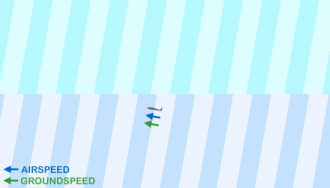Talk:Dynamic soaring
| Aviation: Gliding Start‑class | |||||||||||||||||||
| |||||||||||||||||||
Removed photo of Glasflügel H-301 Libelle
Not sure why this photo was there, since DS is not common in manned planes, is not specific to that model of plane, and the photo did not help explain what DS is. Hermanoere (talk) 16:58, 29 November 2010 (UTC)
Removed Larry Fogel reference
The article referenced questions whether R/C planes are really achieving dynamic soaring, or whether they are just working circulatory lift on the back side. It's pretty clear that DS is the only way to extract enough energy to go 400+ mph. Hermanoere (talk) 23:53, 1 December 2010 (UTC)
Animations
For the benefit of people who are trying to understand how DS works I would like add an animated diagram directly to the article. I suggest adding it before the last paragraph, or within a new section where the physics is briefly explained. Here my suggestion for the new section:
Basic Mechanism
While different flight patterns can be employed in dynamic soaring, the simplest example to explain the energy extraction mechanism is a closed loop across the boundary layer between two airmasses in relative movement. The gain in speed can be explained in terms of airspeed or groundspeed. The glider gains airspeed twice during the loop, when it pierces the boundary layer at an acute angle. Since the 180°-turns retain most of the airspeed the glider completes the loop within the initial airmass at a higher airspeed. The gain in groundspeed occurs when the glider performs a 180°-downwind-turn within the moving airmass. Since the opposite 180°-turn is done within the stationary airmass the groundspeed gain is not reversed. The energy is extracted by reducing the velocity difference between the two airmasses, during the 180°-turns which accelerate air in the opposite directions.
I would also like to link the extended version under External Links. It introduces the concept through a simpler analogy:
http://www.youtube.com/watch?v=SVN-oF6tPLc



